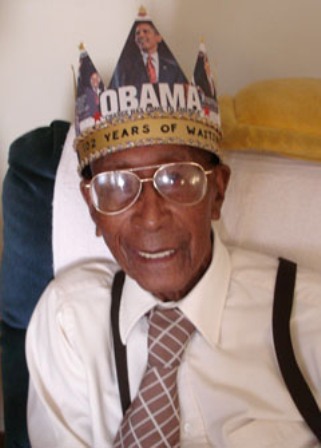Grover Barnes Dies at Age 103
1906-2010
I don’t remember when I first met Grover Barnes. It may have been at St. Paul AME Church where he was a member for more than 60 years. I may have met him at a City Council meeting, as he often addressed the council on civic matters affecting our community. Perhaps I met him at the neighborhood supermarket on Milpas Street where we both shopped. Wherever it was, more than likely, he extended his hand, with a broad smile, and announced, “I’m Grover Barnes, pleased to meet you.” He was always impeccably dressed, extremely polite, and charmingly gracious.

Living on Santa Barbara’s Eastside and retired from 40 years working as a renowned bell captain at the famed Hotel Miramar, Mr. Barnes was active in civic, religious, and social endeavors, supporting every effort and event that was for the betterment of the community. He belonged to the George Washington Carver Scholarship Club, which raised money to buy books and help pay tuition for African-American students. He was also a valued member of the NAACP. In the words of Mrs. Clevonease Johnson, who worked with him in both organizations, “He paid his dues, attended the meetings regularly, and always had something constructive to contribute to the discussions.”
I knew him best as part of the Eastside Study Group. I remember Mr. Barnes coming over to speak with me after my first meeting and expressing his appreciation for my participation. According to Santa Barbara City Councilmember Grant House, a cofounder of the organization, Mr. Barnes, active from the group’s inception, liked the idea of working with his neighbors in a spirit of cooperation. He attended meetings regularly, a strong advocate for improved street lighting and passionate about developing initiatives that met the needs of youth.
But Mr. Barnes’s interest in civic and social affairs was most exemplified by his well-documented history as a prolific writer of letters to the editors of Santa Barbara newspapers, elected officials, and other individuals in decision-making positions. In these letters, most of which were handwritten, he commented on issues of the day, provided historical examples to illustrate his point, and often ended with some philosophical advice for the reader.
Mr. Barnes was an amateur photographer and something of an historian: Through the years, he created a photographic legacy of Santa Barbara’s African-American community. He had his own photo gallery and historical archive, in a little building behind his house on Gutierrez Street.
I first visited Mr. Barnes’s studio when he invited my husband, photographer Rod Rolle, to come and take pictures of his photographic collages. I was completely amazed. He had created large, poster-sized vignettes of people and organizations in the African-American community. These works included not only people from this region, but national and internationally known personalities as well. He combined his own photography with news clippings from local and regional newspapers and the national black press, such as Ebony and JET magazines and the Los Angeles Sentinel.
I visited his home again a few years ago, accompanied by UCSB Librarian Sylvia Curtis, who was representing the Special Collections division and wanted to talk with Mr. Barnes about making the Davidson Library a repository for his collection. On this visit, Mr. Barnes showed us scrapbooks and files of his correspondence over the years; letters he had written and responses he’d received from persons across the spectrum. Since then, Mr. Barnes has indeed gifted his considerable legacy of photographs and correspondence to the California Ethnic and Multicultural Archives (CEMA) at UCSB.
Mr. Barnes treated everybody in the community as his neighbor. Once, I was visiting a friend who had baked a blackberry cobbler with berries from Mr. Barnes’s yard. Several days later, I ran into Mr. Barnes and commented on the cobbler and on how blackberries reminded me of my childhood in North Carolina. Within a few hours, Mr. Barnes knocked on my door with a small bag of blackberries, “the last of the season,” he said, freshly picked from his yard.
Mr. Barnes always had a story to tell. Many were the anecdotal recounts of his experiences as a black man in Texas, Santa Barbara, Montecito, and Southern California — stories that reflected the social construct of America for most of the 20th century. One of his stories harkened back to his motorcycle-riding days. It happened that his bike broke down while he was traveling through Ventura on his way back to Santa Barbara. It was late, and no repair shops were open, so he had to spend the night, but no hotel would rent a room to a black man. Although he had broken no laws and was not under arrest, it was arranged for him to spend the night in the jail so that he wouldn’t have to sleep on the street. The next day, his motorcycle was repaired, and he continued on his way home to Santa Barbara.
In recent years, Mr. Barnes received well-deserved recognition from community organizations like the Brotherhood of Santa Barbara and his church, St. Paul AME, and even from The Independent, which in 2001 honored him as a Local Hero. Most spectacular was the celebration, mounted by his friends and family, of his 100th birthday in 2006. People came from around the country, and he was honored with proclamations from the City of Santa Barbara and the U.S. Congress and showered with gifts and well-wishes from people who knew him throughout his life. Mr. Barnes leaves an indelible memory in our local history and in our hearts.
A viewing will be held Thursday, May 13, 9 a.m.- 5 p.m. at Welch-Ryce-Haider Funeral Chapels, 15 East Sola Street. Services take place May 14, 11 a.m., at First United Methodist Church, 305 East Anapamu Street. In lieu of flowers, donations to St. Paul AME Church, 502 Olive Street, Santa Barbara, CA 93101.



